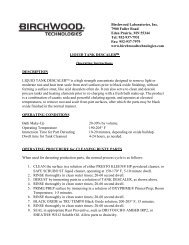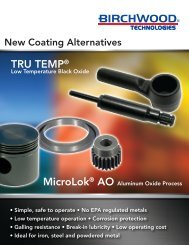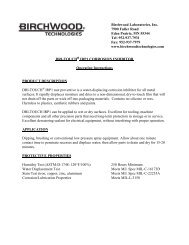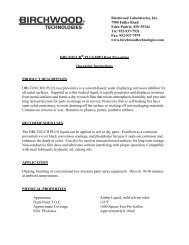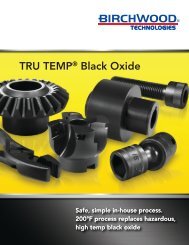Create successful ePaper yourself
Turn your PDF publications into a flip-book with our unique Google optimized e-Paper software.
A general rule is: More reactive alloys, such as low Carbon steels, cast irons and powder metalsreactive quickly and require only 2-4 minutes immersion in this tank. Middle of the road alloys,such as heat-treatable grades, medium Carbon steels are somewhat less reactive and will require5-8 minutes immersion. Low reactive alloys, such as O1, A2, D2, M2 may require 10-15 minuteimmersions in this tank to make them reactive enough to blacken well.Here, again, your BIRCHWOOD TECHNOLOGIES representative can offer guidance.Tank 4 - Overflowing Rinse Tank: room temperature; 20 seconds.This rinse removes OXYPRIME residues before the parts enter the blackening tank. Keeping itclean helps ensure that the chemical balance of the blackening solution is maintained at properlevels.Tank 5 – TRU TEMP Black Oxide Tank: 200-205°F, 10-12 minutes.The parts are now free of oil and chemically prepared for blackening. They are ready forTRU TEMP black oxide, which converts the metal surface to black magnetite.The TRU TEMP black oxide bath can be operated as a semi-permanent bath in the line, requiringonly periodic replenishment with fresh concentrate. BIRCHWOOD TECHNOLOGIES suppliestest kits which allow the user to determine the strength of the bath and make proper additions.Tank 6 - Overflow Rinse Tank: room temperature; 20 second immersion.This rinse step is somewhat less critical than the others in the line. However, blackening residuesmust be rinsed off prior to the sealing steps.Tank 7 - Sealant Tank: room temperature; 1 minute immersion.Because the black coating has a porous crystal structure, it acts as an excellent absorbent base fora protective oil, wax or other suitable top coating. In fact, the coating lets the steel hold more oilthan it normally would and results in a dramatic increase in corrosion resistance.The type of sealant used is determined by the end use of the part. It is possible to produce avariety of finish properties by choosing the appropriate sealant.



